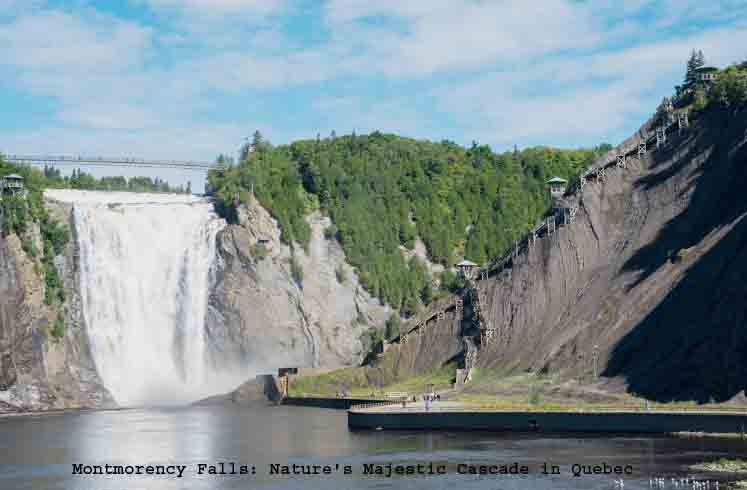
Introduction
Nestled within the picturesque landscapes of Quebec, Canada, Montmorency Falls stands as a testament to the raw beauty and power of nature. Towering at a height even greater than the iconic Niagara Falls, Montmorency Falls captivates visitors with its breathtaking cascade of water, lush surroundings, and rich history.
This article explores the allure of Montmorency Falls, delving into its geological formation, cultural significance, recreational offerings, and the enchanting experiences it provides for locals and tourists alike.
Geological Formation
Montmorency Falls is a natural wonder shaped by the forces of geology and time. The falls are located along the Montmorency River, which flows into the Saint Lawrence River. The source of the Montmorency River is Mont Tremblant, a prominent peak in the Laurentian Mountains. As the river meanders through the landscape, it encounters varying terrain, leading to the creation of the falls.
The falls themselves are a stunning display of cascading water, plummeting 83 meters (272 feet) into the basin below. The dramatic drop creates a mesmerizing spectacle, with mist rising into the air and rainbows often gracing the scene when the sunlight hits the spray. The geological formation of Montmorency Falls serves as a testament to the dynamic processes that have shaped the region over millennia.
Cultural Significance
Montmorency Falls holds significant cultural importance for the people of Quebec. The falls are named after Henrietta of England, Duchess of Orléans, who was married to the French Prince Philippe de France, Duke of Orléans. Henrietta’s title in French, “Duchesse de Montmorency,” inspired the name of the falls.
Indigenous peoples, including the Huron-Wendat and Iroquois, inhabited the region long before the arrival of European settlers. For these indigenous communities, the falls held spiritual significance and were often regarded as sacred sites. The natural beauty and powerful presence of Montmorency Falls contributed to the spiritual connection between the land and its original inhabitants.
As European settlers arrived in the area, the falls became not only a natural wonder but also a site for economic development. Mills were constructed along the Montmorency River to harness the power of the falls for grinding grain and sawing lumber. Over time, the falls became a symbol of both natural beauty and industrial progress, weaving themselves into the cultural fabric of the region.
Recreational Opportunities
Beyond its cultural and historical significance, Montmorency Falls offers a plethora of recreational opportunities for visitors. The falls are easily accessible, with well-maintained trails and viewing platforms providing breathtaking vantage points. One of the most popular ways to experience the falls is by taking the suspension bridge that spans the crest of the falls, offering an exhilarating perspective of the rushing water below.
Adventurous souls can take the staircase that hugs the cliffside, providing a closer look at the falls and allowing for a sense of immersion in the natural surroundings. During the winter months, the falls transform into a winter wonderland, with frozen formations creating a magical spectacle. Ice climbing enthusiasts flock to Montmorency Falls to conquer the frozen walls, adding an extra layer of excitement to the already captivating site.
For those seeking a more leisurely experience, the Montmorency Falls Park offers beautifully landscaped grounds with picnic areas, walking trails, and interpretive displays. The park provides an ideal setting for a relaxing day outdoors, surrounded by the soothing sounds of rushing water and the lush greenery of the surrounding landscape.
The Montmorency Manor
Perched on the cliffs overlooking the falls, the Montmorency Manor adds a touch of elegance and history to the experience. Originally built in the 17th century, the manor has undergone various renovations and restorations over the centuries. Today, it stands as a testament to the architectural heritage of the region.
The Montmorency Manor offers guided tours that delve into the history of the falls, the manor itself, and the people who have called it home. Visitors can explore the well-preserved rooms, each telling a story of the past. The manor also hosts cultural events, art exhibitions, and performances, further enriching the visitor’s experience and connecting them to the rich tapestry of Montmorency Falls’ history.
Events and Festivals
Montmorency Falls is not only a destination for natural beauty and outdoor activities but also a venue for various events and festivals throughout the year. The falls become a focal point for celebrations during special occasions, attracting locals and tourists alike.
During the summer months, the Montmorency Falls International Fireworks Competition illuminates the night sky with dazzling displays of pyrotechnic artistry. This annual event brings together fireworks enthusiasts and professionals from around the world to showcase their skills against the backdrop of the falls. The combination of cascading water and colorful explosions creates a spectacle that is both awe-inspiring and unforgettable.
In addition to the fireworks competition, Montmorency Falls hosts cultural festivals, music concerts, and environmental awareness events. These gatherings celebrate the diversity of Quebecois culture, offering a platform for artists, musicians, and environmentalists to come together and share their talents and passions.
Ecotourism and Conservation
Montmorency Falls has become a focal point for ecotourism and conservation efforts in Quebec. The surrounding area is home to diverse flora and fauna, and efforts are made to preserve and protect this natural habitat. Visitors are encouraged to engage in responsible tourism practices, respecting the environment and minimizing their ecological impact.
Educational programs and guided tours within Montmorency Falls Park emphasize the importance of conservation and environmental stewardship. Visitors can learn about the native plant species, the migratory patterns of local wildlife,
and the efforts to maintain the ecological balance of the region. By promoting awareness and understanding, Montmorency Falls contributes to the broader conversation on sustainable tourism and the need to protect natural wonders for future generations.
Conclusion
Montmorency Falls stands as a symbol of the intricate interplay between nature, culture, and history. From its geological formation and cultural significance to the array of recreational opportunities it offers, the falls are a multifaceted destination that continues to captivate the hearts of those who visit.
Whether it’s the thrill of standing on the suspension bridge, the serenity of exploring the Montmorency Manor, or the spectacle of fireworks lighting up the night sky, Montmorency Falls weaves a tapestry of experiences that leaves an indelible mark on all who witness its majesty.
As a beacon of natural beauty and a testament to the resilience of the environment, Montmorency Falls invites us to connect with the power and grace of the natural world, urging us to appreciate, protect, and cherish the wonders that Mother Nature so generously bestows upon us.









